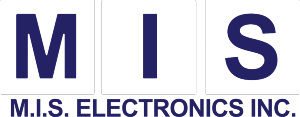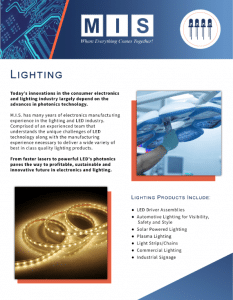photonics manufacturing
Advancing the LED light industry
Photonics Technology
MIS has many years of electronics manufacturing experience in the lighting and LED industry. Our experienced team understands the unique challenges of manufacturing LED technology so we can deliver a wide variety of best-in-class quality lighting products. Today’s innovations in the consumer electronics and lighting industry largely depend on the advances in photonics technology. From faster lasers to powerful LED’s, photonics paves the way to a profitable, sustainable, and innovative future in electronics and lighting.
What is an LED?
LED stand for light-emitting-diode. It is a semiconductor device that emits visible light when an electric current passes through it. The light is not bright, but in most LEDs it is monochromatic, occurring at a single wavelength. The output from anLED can range from red (at a wavelength of around 700 nanometers) to blue-violet (near 400 nanometers). LEDs are comprised of compound semiconductor materials which are made up of elements from group III and group V of the periodic table.
Advantages of LED lights
- Can be powered from a portable battery pack or even a solar array.
- Can be integrated into a control system.
- Are small in size and resistant to vibration and shock.
- Have a very fast “on-time” (60 nsec vs 10 msec for an incandescent lamp).
- Have good color resolution and present low, or no, shock hazard.
Brightness
LEDs may be little, but new high-brightness models in the last 6 years produce a considerable amount of light. Used for status and indicator lamps, under-shelf illumination, accent lighting, and directional marking applications, high-brightness LEDs are now a feasible option in general purpose lighting.
Did you know?
Cold light (no heat)
Light-emitting diodes (LEDs) are solid-state devices that convert electric energy directly into light of a single color. Because they employ “cold” light generation technology, in which most of the energy is delivered in the visible spectrum, LEDs do not waste energy in the form of non-light producing heat. In comparison, most of the energy in an incandescent lamp is in the infrared (or non-visible) portion of the spectrum. As a result, both fluorescent and HID lamps produce a great deal of heat.
Diode chip
The centerpiece of a typical LED is a diode that is chip-mounted in a reflector cup and held in place by a mild steel lead frame connected to a pair of electrical wires. The entire arrangement is then encapsulated in epoxy. The diode chip is generally about 0.25 mm square. When current flows across the junction of two different materials, light is produced from within the solid crystal chip. The shape, or width, of the emitted light beam is determined by a variety of factors: the shape of the reflector cup, the size of the LED chip, the shape of the epoxy lens and the distance between the LED chip and the epoxy lens. The composition of the materials determines the wavelength and color of light. In addition to visible wavelengths, LEDs are also available in infrared wavelengths, from 830 nm to 940 nm.
Average life
The definition of “life” varies from industry to industry. The useful life for a semiconductor is defined as the calculated time for the light level to decline to 50% of its original value. For the lighting industry, the average life of a particular lamp type is the point where 50% of the lamps in a representative group have burned out. The life of an LED depends on its packaging configuration, drive current, and operating environment. A high ambient temperature greatly shortens an LED’s life
Colour of LED light
Additionally, LEDs now cover the entire light spectrum, including red, orange, yellow, green, blue, and white. Although colored light is useful for more creative installations, white light remains the holy grail of LED technology. Until a true white is possible, researchers have developed three ways to deliver it:
- Blend the beams. This technique involves mixing the light from multiple single-color devices. (Typically red, blue, and green.) Adjusting the beams’ relative intensity yields the desired color.
- Provide a phosphor coating. When energized photons from a blue LED strike a phosphor coating, it will emit light as a mixture of wavelengths to produce a white color.
- Create a light sandwich. Blue light from one LED device elicits orange light from an adjacent layer of a different material. The complementary colors mix to produce white. Of the three methods, the phosphor approach appears to be the most promising technology.
The LED market
The LED lighting market is primarily driven by benefits offered by LED lights over incandescent and fluorescent lamps. In additions, the energy efficiency of LED lights, higher brightness, and longer life span are some of the major reason offers tremendous market opportunities for LED lighting in the coming years. Continuous new product introduction by manufacturers such as Phillips and GE with innovative technology are attracting customer attention globally. Screen and display backlighting market development are likely to open new doors for the LED lighting demand.
High Demand
Consumers want cost-effective, energy-saving LED lighting
Lighting consumes approximately 15% of total global power consumption. Moreover, lights produce around 5% of global carbon emission. Thus, the United Nations Environment Programme (UNEP) has released certain guidelines on energy-saving lighting solutions to reduce carbon emissions. With rapid urbanization and rapid economic growth, the lighting industry is expected to grow exponentially over the next two decades, resulting in more high demand for LED based lighting. Thus, need for more LED-based lighting for effective energy saving and cost saving is expected to drive the Industrial and commercial LED lighting market growth in the coming years.
Replace traditional lighting
Conventional lighting consumes a high amount of energy and requires a glass bulb to contain essential coatings and/or gases. For instance, fluorescent lamps generate light using a gas discharge to excite phosphors; high-intensity discharge (HID) lamps utilize an electric arc discharge, while incandescent lamps rely on a heated filament to emit light. In case of an LED, it has the ability to directly convert electrical energy into light energy, which characterizes it with less power consumption and higher reliability. In addition, LEDs have become highly efficient over traditional lighting, owing to characteristics such as extremely small & compact size and prolonged durability, which is expected to increase LED demand in industrial and commercial sector.
Increased adoption of smart lighting
Smart lighting solutions are expected to provide huge momentum in the process of building smart cities. Smart lighting addresses sustainable development challenges successfully, thereby creating ample opportunities for the industrial and commercial LED lighting market. The smart cities market was valued at $517.63 billion in 2017, and is projected to reach $2,402.12 billion by 2025, registering a CAGR of 21.28% from 2018 to 2025.
Governments have been playing a major role in smart cities market through their regulations and initiatives focused on deployment of smart services as a major part of their infrastructure. Government regulations for smart city deployment supported by adoption of new technologies that support Industry 4.0, smart energy projects, & e-governance solutions, rapid urbanization, and need for better quality of life is expected to increase smart lighting demand over the forecast period.
Circuit board assembly is one piece of the turnkey puzzle. Trust MIS Electronics to manage your product from custom design to delivery, ensuring a retail-ready board without errors.
- On-time delivery
- Cost control
- Fast prototyping
- Highest quality
- Total care support
Ready to get started?
Our Office
MIS Electronics Inc.
174 West Beaver Creek Rd.
Richmond Hill, ON L4B 1B4 Canada
ISO 9001:2015 registered
ISO 13485:2016 registered
Office Hours
Mon-Fri: 9am - 5pm (EST)
Sat-Sun: Closed
Electronics careers
Certifications
Our Office
MIS Electronics Inc.
174 West Beaver Creek Rd.
Richmond Hill, ON L4B 1B4 Canada
ISO 9001:2015 registered
ISO 13485:2016 registered
Office Hours
Mon-Fri: 9am - 5pm (EST)
Sat-Sun: Closed
Contact Us
1 905-707-2305

